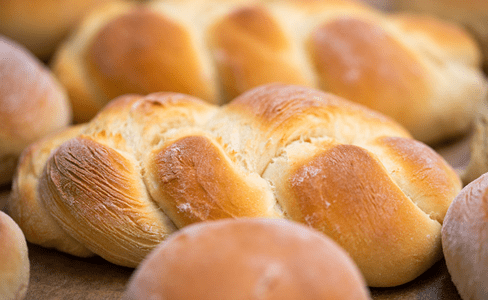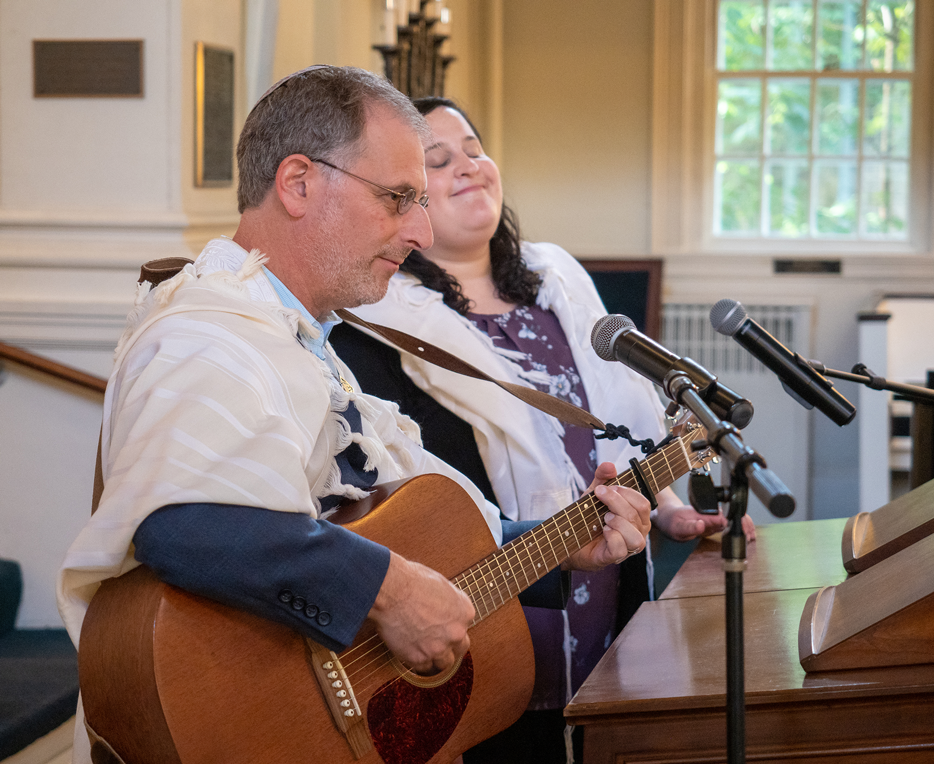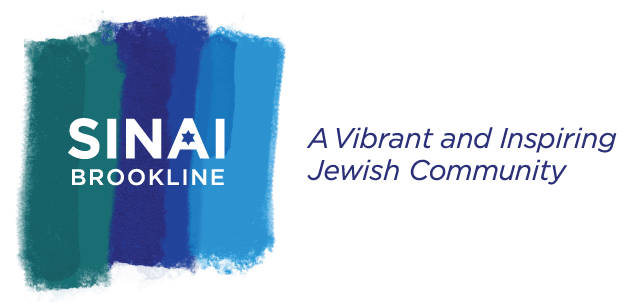Shabbat at Sinai

Welcome to Sinai Shabbat
Shabbat at Temple Sinai is an opportunity to step back, breathe deeply, and renew the spirit. Through beautiful music, moving prayer, an inspiring D’var Torah, sermon or guest speaker, and the warmth of friends and community we welcome Shabbat as a special interlude in our week. Everyone is invited to celebrate the beauty and joy of Shabbat!
We are delighted to have you worship with us. We encourage families to share their life cycle events, such as baby namings, conversions, and major anniversaries, with us at a Shabbat service. If you are a guest or new to our congregation, please introduce yourself to a greeter, other members, and our rabbis. We would love to meet you and help you feel at home.
Erev Shabbat
We gather on Friday evenings to welcome Shabbat in our beautiful Sanctuary, led by our rabbis and cantorial soloist. Once a month, our Shabbat Band enlivens our service with joyous guitars, clarinet, violin, drums, and vocals. Special annual events include Rainbow Shabbat and various renowned speakers. All services are multi-access (held in-person and available remotely).

Shabbat Schedule
General schedule of Erev Shabbat Services
Check our calendar for more specific details
- All Friday night services from September through May are held at 6:00 pm.
- During the summer months (June through August), Friday night services are led by community members at 6:00 pm in the Weintraub Community room. (Enter through the Sewall Street entrance.)
Shabbat Morning
We offer a variety of opportunities on Shabbat mornings at Temple Sinai, including worship, Torah study and discussion, and Tot Shabbat.
- On the 1st Saturday of each month, at 9:30 a.m., we host an opportunity to pray and meditate as a community during our Community Shabbat Morning Minyan. At this service led by our rabbis, Temple Sinai members read Torah and Haftarah and lead the Torah discussion or D’var Please check our calendar for details.
- On many Saturdays, we hold Shabbat worship, including B’nai Mitzvah ceremonies, led by Rabbi Vogel in our Sanctuary beginning at 10:30 a.m. Please check our calendar for details
- Twice monthly on the 2nd & 4th Saturdays of the month, at 9:00 a.m., Rabbi Vogel leads Shabbat Morning Torah Study, a discussion of Jewish ideas as they emerge from the week’s Torah portion.
- Once monthly (usually on the 3rd Saturday of the month), we hold Tot Shabbat, an interactive service with singing and storytelling for families with young children (0-5 years old). Please check our calendar monthly for time and location.
- To learn more about a Shabbat service and to access text and sound files of Shabbat blessings, explore this URJ website.
What to Expect at Shabbat Services
Our Shabbat service reflects a blend of traditional and liberal expressions of Jewish thought and ritual. They emphasize both the importance of the Hebrew language and the beauty of traditional Jewish music. The order of the service includes a number of prayers and meditations that praise God, acknowledge the wonder of life, and thank God for the many blessings we receive. There is time for silent prayer as well as responsive readings. Many services include a D’var Torah or a discussion of a contemporary issue. Our service generally includes the following components:
Kabbalat Shabbat
On Friday evenings, we enter into Shabbat by lighting Shabbat candles and welcoming the presence of Shabbat with singing, adapting the 16th-century practice of preparing to greet Shabbat with music and meditation, an opportunity to experience the blessing, rest, and peace that Shabbat can bring. We sing selected verses of the L’cha Dodi song, symbolically welcoming Shabbat by facing the entrance of our Sanctuary to greet Shabbat. We encourage the congregation to greet one another and introduce themselves to one other as a community.
The Bar’chu
We call one another to prayer: After initial readings and/or songs, the evening or morning services proper begin with the Bar’chu, a call to worship that dates back to the time of the Temple in Jerusalem. Our practice is to face the Ark for this opening call to prayer.
The Sh’ma and its blessings
This section expresses three major themes: creation, revelation, and redemption. The Sh’ma, the watchword or motto of the Jewish people, declares our belief not only in the unity of God but also in the unity of all humanity.
The Amidah
This is the central prayer of the liturgy. In a weekday service, this would include a series of petitions to God, but on Shabbat, we content ourselves with prayers of praise and thanksgiving. We usually chant the first section of the Amidah, including a meditation that God opens our lips and our hearts and prayer, and continuing with the first prayer, the Avot v’Imahot, reminding ourselves of our ancestors’ spiritual paths. We provide an opportunity for the entire congregation to pray silently, using the words of a prayerbook or their own personal meditations, and to be seated as they are ready.
Learning
Jewish learning is a central part of Friday evening and Saturday morning Shabbat services. Our rabbis regularly share a D’var Torah, an interactive discussion, or a short “vort” (word) of Torah. We frequently welcome Shabbat speakers and occasionally invite our Religious School students to share their own Jewish learning in a group D’var Torah.
The Concluding Prayers
The Aleynu confirms that we are obliged to serve as God’s partners in the completion of creation and help repair the world. The Kaddish is recited by the congregation in memory of those who died within the last year, the past 30 days (sheloshim), or on the anniversary of a death (the yahrzeit). The Kaddish prayer does not mention death but praises God for life and the universe. The service concludes with the Kiddush, the blessing over wine. In it, we sanctify the Sabbath and recall how God rested after the six days of creation and how God released us from slavery in Egypt. We note the natural alternation between work and rest by blessing wine, a symbol of the Jewish belief that physical pleasure is part of the divine plan for humanity.
Our Prayer Books and the Torah
Our congregation uses Mishkan T’filah, the modern, accessible, and creative Reform prayer book published in 2007. Mishkan T’filah includes transliteration into English, easy-to-follow pagination, and poetic translations of the Hebrew prayers. Like other Reform congregations, we pray in both Hebrew and English. We encourage you to participate and join in singing with the community!
We can provide large-sized prayer books for those with vision disabilities, and provide assisted listening devices for those with limited hearing. Please speak with a greeter, who will be happy to help you.
The Torah is a hand-lettered parchment scroll containing the first five books of the Hebrew Bible: Genesis, Exodus, Leviticus, Numbers, and Deuteronomy. The Torah is housed in the ark, behind the velvet curtain at the front of the temple on the bimah. The Torah is revered and treated with great respect. It is dressed in an ornamental cover and adorned with a silver crown and breastplate. These decorations are symbolic of the priestly robes of Aaron, Moses’ brother. When the ark is open and the Torah is visible, the congregation stands. A trained scribe called a sofer, who inscribes special ink on parchment, letters each Torah scroll. It contains only the consonantal text of the Torah without any vowels or punctuation marks. In order to chant from the scroll, one must first learn the melody by heart since the scroll does not contain musical notations. It is an honor to read or chant from the Torah.
Kipot and Tallitot
In the Reform movement today, more people are wearing a Tallit (prayer shawl) and/or a Kippah (head covering, also, yarmulke) to enhance their spiritual experience during worship. At Temple Sinai, wearing these items is optional and encouraged.
The Tallit has fringes (tzitzit) on its four corners, meant to remind us of commandments we may observe to make our lives holy (see Numbers 15:37-41). A Tallit is worn only during morning services and on the evening of Yom Kippur. Wearing a Kippah is a sign of humility and respect toward God. It is commonly worn during prayer but can be worn also at other times. It can also be an outward sign of Jewish religious identification and pride.
Today, both of these ritual practices are being renewed by Reform Jews. Often, members of our community will wear, or even create, their own Tallitot (plural, also: Tallises), many of which contain bright colors, or were purchased in Israel or by a dear relative. Kippot are beginning to be worn again in Reform congregations during prayer. Our rabbis encourage members of Temple Sinai — both men and women, and boys and girls of bar and bat mitzvah age and beyond — to try on these ritual clothing items, as another way to experiment with and re-claim ancient Jewish practices in new and modern ways.
Tallitot are available in the rear of our Sanctuary and Kippot are available in a basket as you enter.
Flowers & Oneg
Flowers for our Bimah and/or food for the pre-service nosh are often donated by temple members in commemoration of a special event such as a wedding, B’nai Mitzvah, special birthday, anniversary, conversion, recovery from an illness, or the birth or adoption of a child or grandchild. On Friday evenings, Temple Sinai members may sponsor the pre-service “nosh” at 5:30 p.m. (a light snack of fruit, vegetables, cheese and crackers). To sponsor flowers or a “nosh,” please contact our office at 617-722-5888 or office@sinaibrookline.org.
Music at our Shabbat Services
At Temple Sinai, we believe that music elevates the soul and deepens our Shabbat prayer experience and our connection with God. At Shabbat services, we strive to create a musical environment that invites members of the congregation to sing, and to experience uplift as they participate actively in prayer.
We regularly use piano and guitar at Shabbat services. Once a month, Shabbat services are accompanied by a Shabbat band to add clarinet, violin, drums, ukulele, and vocals. We hope our congregation experiences the joy and rest of Shabbat through music, as well as meditative opportunities, facilitated by beautiful Jewish prayer music.
We invite you to enrich your own prayer and Shabbat experience by learning more about the music of Jewish prayer. Here are web links to some of the music and prayers that we often sing at Shabbat morning or evening services at Temple Sinai:
L’chu N’ranena (for Friday night)
Mizmor Shir L’Yom HaShabbat (composed by Yoel Sykes)
Adonai Oz (Psalm 29) – (composed by Yoel Sykes)
L’cha Dodi – for Friday evening (composed by Nava Tehillah)
L’cha Dodi – for Friday evening (composed by Abie Rotenberg)
L’cha Dodi – for Friday evening (as sung at Congregation Kol HaNeshama in Jerusalem)
Shir Chadash (Psalm 96, for Friday night) – composed by Julie Silver
Barchu (call to prayer) – composed by Cantor Rachelle Nelson
Barchu (call to prayer) – composed by Noah Aronson [includes English, which we do not generally sing at Temple Sinai]
Halleluyah (Psalm 150, for Shabbat morning) – composed by Debbie Friedman
V’shamru (Torah verses about Shabbat) – composed by Shlomo Carlebach
V’shamru (Torah verses about Shabbat) – composed by C. Rothberg
Adonai S’fatai Tiftach (meditation before the Amidah) – composed by Craig Taubman
Shalom Rav (Friday evening prayer for peace) – composed by Jeff Klepper & Danny Friedlander
Mi Sheberach (prayer for healing for body and mind) – composed by Debbie Friedman
Yedid Nefesh (Friday evening melody to welcome Shabbat) – folk melody
Sh’ma (version occasionally sung at Temple Sinai on Friday nights) – composed by Tzvika Pik
Kol Yoshvei Tevel (composed by Joel Segel)
Kedushah Shabbat morning
Current Events at Sinai Brookline
Click here to visit our calendar for all the latest events and programs at Sinai Brookline
